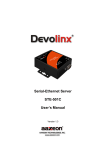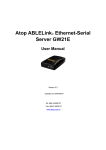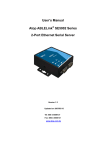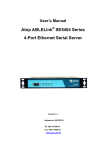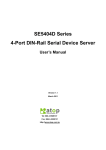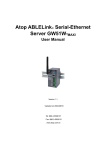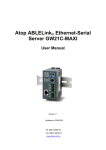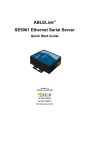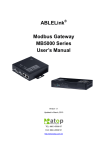Download ABLELink SE5001 Ethernet Serial Server
Transcript
ABLELink ® SE5001 Ethernet Serial Server User Manual Version 1.3 Updated on 2007/05/24 Tel: 886-3-5508137 Fax: 886-3-5508131 http://www.atop.com.tw User Manual Version 1.3 SE5001 Ethernet Serial Server Important Announcement The information contained in this document is the property of Atop Technologies, Inc. and is supplied for the sole purpose of the operation and maintenance of products of Atop Technologies, Inc. No part of this publication is to be used for any other purposes, and it is not to be reproduced, copied, disclosed, transmitted, stored in a retrieval system, or translated into any human or computer language, in any form, by any means, in whole or in part, without the prior express written consent of Atop Technologies, Inc. Published by Atop Technologies, Inc. 2F, No. 146, Sec. 1, Tung-Hsing Rd. Jubei, Hsinchu 30261 Taiwan, R.O.C. Tel: 886-3-5508137 Fax: 886-3-5508131 www.atop.com.tw Copyright © 2006 Atop Technologies, Inc. All rights reserved. All other product names referenced herein are registered trademarks of their respective companies. Copyright © 2006 Atop Technologies, Inc. All rights reserved. Designed in Taiwan. 1 User Manual Version 1.3 SE5001 Ethernet Serial Server This document is intended to provide customers with brief descriptions on the product and to assist customers to get started. For detail information and operations of the product, please refer to the manual in the CD attached. FCC WARNING Class A for Ethernet Serial Server (Model SE5001) This equipment has been tested and found to comply with the limits for a Class A digital device pursuant to Part 15 of the FCC rules. These limits are designed to provide reasonable protection against harmful interference when the equipment is operated in a commercial environment. This equipment generates, uses and radiates radio frequency energy and, if not installed and used in accordance with the instructions, may cause harmful interference to radio communications. Operation of this equipment in a residential area is likely to cause harmful interference in which case the user will be required to correct the interference at his own expenses. A shielded-type power cord is required in order to meet FCC emission limits and also to prevent interference to the nearby radio and television reception. It is essential that only the supplied power cord can be used. Use only shielded cables to connect other devices to this equipment by RS-232 or RS-485 ports. Be cautioned that changes or modifications not expressly approved by the party responsible for compliance could void ones authority to operate the equipment. Copyright © 2006 Atop Technologies, Inc. All rights reserved. Designed in Taiwan. 2 User Manual Version 1.3 SE5001 Ethernet Serial Server Contents 1. Introduction.......................................................................................................................................................6 1.1 Packaging........................................................................................................................ 6 2. Hardware Setup...............................................................................................................................................9 2.1 LED Indicators ............................................................................................................... 10 2.1.1 LAN LED .............................................................................................................. 10 2.1.2 COM Port LED ..................................................................................................... 10 2.1.3 RUN LED ............................................................................................................. 10 2.2 Installation Procedures .................................................................................................. 10 3. Software Setup...............................................................................................................................................11 3.1 Configuration by Monitor.exe Utility ............................................................................... 11 3.1.1 Static IP ................................................................................................................ 11 3.1.2 Auto IP (Dynamic IP) ............................................................................................ 12 3.2 Configuration by Telnet Utility ........................................................................................ 13 3.2.1 Login to the System ............................................................................................. 13 3.2.2 Networking ........................................................................................................... 15 3.2.3 Change the Password .......................................................................................... 16 3.2.4 COM1 Setup ........................................................................................................ 16 3.2.5 Configure SE5001 as TCP Client......................................................................... 18 3.2.6 Configure SE5001 as UDP Client ........................................................................ 19 3.2.7 COM Port Setting ................................................................................................. 20 3.2.8 Enabling Serial Data Buffer .................................................................................. 20 3.2.9 Setting Packet Delimiter ....................................................................................... 21 3.3 Configuration Using Web Browser ................................................................................ 21 3.3.1 Log in to the System ............................................................................................ 22 3.3.2 Change the password .......................................................................................... 22 3.3.3 Network Setup...................................................................................................... 24 3.3.4 Configure SE5001 as TCP Server ....................................................................... 24 3.3.5 Configure SE5001 as TCP Client......................................................................... 26 3.3.6 Pair Connection.................................................................................................... 28 3.4 Assign a New IP Address by ARP Command ................................................................ 29 4. Using Virtual COM........................................................................................................................................ 31 4.1 Setup of a Virtual COM Driver ....................................................................................... 31 Copyright © 2006 Atop Technologies, Inc. All rights reserved. Designed in Taiwan. 3 User Manual Version 1.3 SE5001 Ethernet Serial Server 4.1.1 Pre-installation Requirements .............................................................................. 31 4.1.2 Cautions on Use................................................................................................... 31 4.1.3 Limitation .............................................................................................................. 31 4.1.4 Installation ............................................................................................................ 32 4.1.5 Uninstalling........................................................................................................... 32 4.2 Virtual COM Communication ......................................................................................... 32 4.2.1 Enable Virtual COM on SE5001........................................................................... 32 4.2.2 Run Serial/IP for Atop on Monitoring PC .............................................................. 34 4.3 Configuring Virtual COM Ports ...................................................................................... 34 5. SNMP Setup................................................................................................................................................... 36 5.1 SNMP Network Management Platform.......................................................................... 36 5.2 Using NetworkView as an Example............................................................................... 36 6. Start Writing Ones Own Applications..................................................................................................... 38 6.1 Preparing the System .................................................................................................... 38 6.2 Running the Sample Program ....................................................................................... 38 6.2.1 TCPTEST in Visual Basic..................................................................................... 38 6.2.2 TCPTEST2 in Visual C......................................................................................... 39 7. Diagnostics .................................................................................................................................................... 40 7.1 Use Standard TCP/IP Utility Ping Command................................................................. 40 7.2 Use Monitor.exe Configuration Utility Program.............................................................. 40 7.3 Use TCPTEST.exe or TCPTEST2.exe Sample Program .............................................. 41 Appendix A: Specifications............................................................................................................................ 42 A.1 Hardware Specifications ............................................................................................... 42 A.2 Software Specifications ................................................................................................. 43 A.3 Panel Layout and Connector Pin Assignments ............................................................. 43 A.3.1 Panel Layout ........................................................................................................ 43 A.3.2 DB9 Pin Assignments .......................................................................................... 44 A.3.3 Ethernet Port (RJ-45)........................................................................................... 44 A.3.4 Power Terminal Block Connector......................................................................... 45 Note: It could be reversed for the pin of VIN- and VIN+................................................ 45 A.4 Buzzer/LED Message ................................................................................................... 45 A.4.1 Buzzer.................................................................................................................. 45 A.4.2 LAN LED .............................................................................................................. 45 A.4.3 COM Port LED ..................................................................................................... 45 Copyright © 2006 Atop Technologies, Inc. All rights reserved. Designed in Taiwan. 4 User Manual Version 1.3 SE5001 Ethernet Serial Server A.4.4 RUN LED ............................................................................................................. 46 Appendix B: Upgrade System Firmware................................................................................................... 47 B.1 Upgrade Procedures ..................................................................................................... 47 B.2 Critical Issues of Upgrading .......................................................................................... 48 B.3 Error Messages............................................................................................................. 49 Appendix C: Disable System Firmware ..................................................................................................... 50 Appendix D: Using Monitor.exe Utility........................................................................................................ 51 D.1 Run the utility ................................................................................................................ 51 D.2 Detect Operational Devices .......................................................................................... 51 D.3 Configure Devices......................................................................................................... 51 Copyright © 2006 Atop Technologies, Inc. All rights reserved. Designed in Taiwan. 5 User Manual Version 1.3 SE5001 Ethernet Serial Server 1. Introduction The SE5001 Ethernet Serial Server is a gateway between Ethernet (TCP/IP) and RS-232 or RS-485/RS-422 communications. The information transmitted by SE5001 is transparent to both host computers (Ethernet) and devices (RS-232 or RS-485/RS-422). Data coming from the Ethernet (TCP/IP) is sent to the designated RS-232 or RS-485/RS-422 port and data being received from RS-232 or RS-485/RS-422 port is sent to the Ethernet (TCP/IP) transparently. In the computer integration manufacturing or industrial automation area, the SE5001 Ethernet Serial Server is used for field devices to direct connect to Ethernet network. Terminal Server (main control program run in SE5001) transforms whatever data received from RS-232 or RS-485/RS-422 to TCP/UDP port then connect devices to the Ethernet network via a single application program or multiple application programs. Many control devices provide the ability to communicate with hosts through RS-232 or RS-485/RS-422 however RS-232 or RS-485/RS-422 serial communication has its limitations. For one, it is hard to transfer data through a long distance. With SE5001, it is possible to communicate with a remote device in the Intranet environment or even in the Internet and thus, increases the communication distance dramatically. SE5001 offers one RS-232 or RS-485/RS-422 port, one RJ45 Ethernet and Watch-Dog Timer etc. 1.1 Packaging Please check ones package contains the following items: SE5001-S2 or SE5001-S5 Serial Server Quick Start Guide Product CD Wall mounting screws 3 pin terminal block for power input Optional Accessories: 1. DK-25 DIN-Rail Kit 2. Power Adapter with DC jack- PIN 1.3φ output 5.0V 1A (1) AD5V1A(US) Switching adapter (2) AD5V1A(EU) Switching adapter 3. Power Adapter with Terminal block output 12V1.25A (1) US315-12(US) Switching adapter (2) US315-12(EU Switching adapter Copyright © 2006 Atop Technologies, Inc. All rights reserved. Designed in Taiwan. 6 User Manual Version 1.3 SE5001 Ethernet Serial Server 1.2 Application Connectivity TCP Server Mode:SE5001 can be configured as a TCP server on TCP/IP Network to wait for other applications(clients) in host computer to establish a connection with the serial device. After the connection is established between serial device and host computer, data can be transmitted in both directions. TCP Client Mode:SE5001 can be configured as a TCP client on TCP/IP Network to establish a connection with other applications(server) in host computer actively. After the connection is established, data can be transmitted between serial device and host computer in both directions. Copyright © 2006 Atop Technologies, Inc. All rights reserved. Designed in Taiwan. 7 User Manual Version 1.3 SE5001 Ethernet Serial Server UDP Mode:UDP is a faster but non-guaranteed datagram delivery protocol.SE5001 can be configured as a UDP mode on TCP/IP Network to establish a connection using unicast or multicast data from the serial device to one or multiple host computers. Vice versa is also true. Tunneling Mode:In the case of the serial connection is established with two or more SE5001 to send data over TCP/IP Network .It can avoid RS-232 interface 15 meter distance limitation imposed. Copyright © 2006 Atop Technologies, Inc. All rights reserved. Designed in Taiwan. 8 User Manual Version 1.3 SE5001 Ethernet Serial Server 2. Hardware Setup NOTE: 1. SE5001-S2 (for RS-232), SE5001-S5 (for RS422/485). Panel layout in Appendix A.3.1 2. One can press the reset button of SE5001 to reset the settings to the default value Figure 2.1 shows the interfaces. Figure 2.1 SE5001 interfaces. Copyright © 2006 Atop Technologies, Inc. All rights reserved. Designed in Taiwan. 9 User Manual Version 1.3 SE5001 Ethernet Serial Server 2.1 LED Indicators 2.1.1 LAN LED Message Description Off Ethernet Disconnected Blinking with Green Data is transmitting on Ethernet for 100Mbps Blinking with Orange Data is transmitting on Ethernet for 10Mbps Table 1. LAN LED Message 2.1.2 COM Port LED Message Description Off No data is transmitting on COM port Blinking Data is transmitting on COM port Table 2. COM Port LED Message 2.1.3 RUN LED Message On Description Jumper JP1 Pin1 and Pin2 are shorted to disable AP firmware running Blinking (rate: 0.5 Sec) AP firmware is running normally Table 3. RUN LED Message 2.2 Installation Procedures Step 1: Connect SE5001 to power source using 5V DC Jack (or 9~30V DC Terminal Block power source) Note:SE5001 provide two power inputs can be connected simultaneously to live DC power sources. Anyone of the power inputs fails, the other live source acts as a backup to support power needs automatically. The redundant dual DC power inputs give one extra assurance of non-stop operation Step 2: Connect SE5001 to ones Ethernet network. Use a standard straight-through Ethernet cable when one connect it to a hub/switch, one also can connect it to ones PC‘s Ethernet port via a cross-over Ethernet cable for easy set up. However, in this case one need to make sure ones PC is in the same network sub-net as SE5001. Step 3: Connect SE5001’s serial port to a serial device. Step 4: Placement options. One can mount SE5001 to a wall/panel (Mounting screws included) or Din-Rail rack (Require optional item model: Din-Rail-Kit DK-25). Copyright © 2006 Atop Technologies, Inc. All rights reserved. Designed in Taiwan. 10 User Manual Version 1.3 SE5001 Ethernet Serial Server 3. Software Setup SE5001 Ethernet Serial Server is shipped with default settings shown in the following table: Property Default Value IP Address 10.0.50.100 Gateway 10.0.0.254 Subnet Mask 255.255.0.0 User Name admin Password Null(leave it blank) COM 1 9600,None, 8, 1, No flow control, buffer disabled, packet delimiter timer 2ms Link 1 Type: TCP Server, Listen port 4660, Filter=0.0.0.0, Virtual COM disabled SysName of SNMP name SysLocation of SNMP location SysContact of SNMP contact 3.1 Configuration by Monitor.exe Utility 3.1.1 Static IP Use monitor.exe that comes with product CD to configure the network parameters of SE5001. Please click “Config” button(ref Figure 3.1) then give it a static IP information.( Figure 3.2) Figure 3.1 Configure by monitor.exe utility Copyright © 2006 Atop Technologies, Inc. All rights reserved. Designed in Taiwan. 11 User Manual Version 1.3 SE5001 Ethernet Serial Server Figure 3.2 Static IP setup dialog window 3.1.2 Auto IP (Dynamic IP) A DHCP server can automatically assign the IP address and network settings. SE5001 supports the DHCP function. By default, the DHCP function on SE5001 is disabled; one can use Monitor.exe software to search network information automatically by following steps: ->Execute Monitor.exe(Figure 3.1) ->Click on the IP address of SE5001 in monitor ->Click “Config” button(It will pop-up Dialog Window) ->Check ”Auto IP” (Figure 3.3) ->Click “ Config Now” button(The SE5001 will restart and get IP from DHCP server automatically) Figure 3.3 monitor.exe Auto IP Dialog Window Copyright © 2006 Atop Technologies, Inc. All rights reserved. Designed in Taiwan. 12 User Manual Version 1.3 SE5001 Ethernet Serial Server 3.2 Configuration by Telnet Utility One can use Telnet utility to change configuration settings of SE5001 by following steps: 3.2.1 Login to the System ->Open Ms-DOS command prompt window ->Telnet to SE5001 using command “Telnet IP_address”.( For example:Input Telnet 10.0.50.100 in Ms-DOS command prompt window).After telnet to SE5001, system prompts for a password, the default password is left it blank. (Figure 3.4) Figure 3.4 Login to the system Note: One can press the default button of SE5001 to reset the password to the default value. 1. After verifying the password, the following terminal screen appears.( Figure 3.5) Figure 3.5 Main menu Note: 1. If SE5001 does not receive any command within 1 minute, Telnet will be terminated automatically. Copyright © 2006 Atop Technologies, Inc. All rights reserved. Designed in Taiwan. 13 User Manual Version 1.3 SE5001 Ethernet Serial Server 2. The changes of networking parameters will take effect only when one exit and restart SE5001. ->Select “1” from “Input choice and enter (0~4):” to enter overview page as following:( Figure 3.6) Figure 3.6 Overview This page gives one the general information of SE5001 including IP and MAC address, SNMP information, kernel and AP version, and connection status of the device. Copyright © 2006 Atop Technologies, Inc. All rights reserved. Designed in Taiwan. 14 User Manual Version 1.3 SE5001 Ethernet Serial Server 3.2.2 Networking Select “2” from “Input choice and enter (0~4):” to enter Networking page as following:( Figure 3.7) Figure 3.7 Network settings This page allows one to change network settings of the device including IP address, subnet mask, gateway IP address and SNMP information of SE5001. Please notice that any setting change made on this page won’t take effect until one restart the device. Note: Press “ESC” key to return to the previous menu . Copyright © 2006 Atop Technologies, Inc. All rights reserved. Designed in Taiwan. 15 User Manual Version 1.3 SE5001 Ethernet Serial Server 3.2.3 Change the Password 1. Select “3” from “Input choice and enter (0~4):” the following screen appears. (Figure 3.8) Figure 3.8 change the password 2. If one want to change the password, please type the old password in the “Please input old password” field, type the new password in the “Please input new password” and the “Please verify new password” fields. Note: One can press the default key of product to reset password to the default value. 3.2.4 COM1 Setup Select “4” from “Input choice and enter (0~4):” the following screen appears: (Figure 3.9) Figure 3.9 Com1 setup The page gives one the opportunity to configure parameters of COM1 setting which include COM1 working mode, port parameters, enabling or disabling serial buffer’s data and setting packet delimiter. Copyright © 2006 Atop Technologies, Inc. All rights reserved. Designed in Taiwan. 16 User Manual Version 1.3 SE5001 Ethernet Serial Server LINK Mode Setup Configure SE5001 as TCP server:(Figure 3.10) Type 1 from “Input choice and enter (1~4):” of COM1 Type 1 in the “Input choice(1~5) and enter:” Input local port in the “Please input local port:” 1.If one want to enable IP filter: Input y in the “Do one want to enable IP filter(y/n)?” Input source IP in the “Please input Filter_IP :” Double click “Enter” key 2.If one don’t want to enable IP filter: Input n in the “Do one want to enable IP filter(y/n)?” Double click “Enter” key Input idle time in “Please input idle time to send TCP alive packet(4*10sec):”(If one input 2->the sending TCP keep alive packet period will be change to 2*10 sec) Note: 1. IP filtering function is disabled if setting FILTER_IP to “0.0.0.0”. 2. IP filter is disabled by default 3. If IP filter is enabled, only source IP assigned can connect to SE5001. Figure 3.10 Link Mode-TCP server setup Copyright © 2006 Atop Technologies, Inc. All rights reserved. Designed in Taiwan. 17 User Manual Version 1.3 SE5001 Ethernet Serial Server 3.2.5 Configure SE5001 as TCP Client Type 2 in the “Input choice(1~5) and enter:“(Figure 3.11) Input destination IP in the “Please input Destination IP:” Input destination port in the “Please input Destination port:” 1.Type 1 for Connected always: Double click “Enter” key Input idle time in “Please input idle time to send TCP alive packet(4*10sec):”(If one input 2->the sending TCP keep alive packet period will be change to 2*10 sec) 2.Type 2 for Trigger by receiving COM port data: Input idle time to disconnect in the “Please input idle time to disconnect(0sec , 1~255):” (If one input 0->disable the function; if one input 2 ->the serial Inactivity beyond 2 sec will cause disconnect) Input error retrying time in “Please input waiting time for error retrying(0 minute,1~255):” (If one input 0->disable the function; if one input 2 ->the serial Inactivity beyond 2 sec will cause disconnect) Double click “Enter” key Input idle time in “Please input idle time to send TCP alive packet(4*10sec):”(If one input 2->the sending TCP keep alive packet period will be change to 2*10 sec) Figure 3.11 Link Mode-TCP client setup Copyright © 2006 Atop Technologies, Inc. All rights reserved. Designed in Taiwan. 18 User Manual Version 1.3 SE5001 Ethernet Serial Server 3.2.6 Configure SE5001 as UDP Client For example the local port is 4660,the destination IP is 10.0.29.254, destination port is 666. ( Figure 3.12) Figure 3.12 Link Mode-UDP client setup Copyright © 2006 Atop Technologies, Inc. All rights reserved. Designed in Taiwan. 19 User Manual Version 1.3 SE5001 Ethernet Serial Server 3.2.7 COM Port Setting Type 2 from “Input choice and enter (1~4):” of COM1, the following screen appears, one can then give the COM port alias name, set the baud rate and parity, determine number of data bit and stop bit, and decide if one want to use flow control and the type of flow control one want to use.( Figure 3.13) Figure 3.13 Com port setting 3.2.8 Enabling Serial Data Buffer Type 3 from “Input choice and enter (1~4):” of COM1, by default COM port serial data buffer is enabled meaning that when TCP/IP Ethernet connection is broken, serial data collected from serial device will be empty in SE5001 once TCP/IP connection is resumed, the serial data will be sent through Ethernet connection, one can disable it if one wish.( Figure 3.14) Figure 3.14 Com port-Enabling serial data buffer Copyright © 2006 Atop Technologies, Inc. All rights reserved. Designed in Taiwan. 20 User Manual Version 1.3 SE5001 Ethernet Serial Server 3.2.9 Setting Packet Delimiter Packet delimiter is a way of controlling packets within serial communication. It can prevent packets from being cut thus keep the packets complete. SE5001 provides two ways of parameter setting as inter character timer and terminator. By default packet delimiter timer is 1 ms, one can change timer shown in the following figure:( Figure 3.15) Figure 3.15 Setting packet delimiter timer One can also choose character pattern as the packet delimiter indicated in the following figure: (Figure 3.16) Figure 3.16 Setting packet delimiter-character pattern 3.2.10 Accept Control Command from COM port SE5001 can also accept serial control commands directly over the network following RFC2217 format. For more detail about this function, please contact Technical Support for more information. 3.3 Configuration Using Web Browser 1. Make sure ones PC is located on the same network sub-net as SE5001 2. Open a web browser, then type in the IP address of SE5001 to be configured. Default user name is admin and default password is null (leave it blank). Copyright © 2006 Atop Technologies, Inc. All rights reserved. Designed in Taiwan. 21 User Manual Version 1.3 SE5001 Ethernet Serial Server 3. SE5001’s network, link mode and COM ports settings can be configured in different web pages. 4. Click “Save Configuration” to save settings. 5. Click ”Restart” button to make the change effective if necessary. It is also possible to modify various settings through the web server interface. To do so, please follow the steps below. 3.3.1 Log in to the System 1. From web browser, type in the IP address of SE5001 in the URL. Example: http://10.0.50.100 2. The following authentication screen appears. (Figure 3.17) Please type in user name and password then click on OK. The user name is admin and password is left it blank by default. Figure 3.17 login the system via Web 3. The following overview page appears.( Figure 3.18) Figure 3.18 Overview 3.3.2 Change the password 1. Click on the “Security” link and the following screen appears.( Figure 3.19) Copyright © 2006 Atop Technologies, Inc. All rights reserved. Designed in Taiwan. 22 User Manual Version 1.3 SE5001 Ethernet Serial Server Figure 3.19 Change the password 2. Please input the old password in the “Old Password” field, input the new password in the “New Password” and the “Verified Password” fields, and then click on “Save Configuration” to update the password. Note: One can press the default key of product to reset password to the default value. Copyright © 2006 Atop Technologies, Inc. All rights reserved. Designed in Taiwan. 23 User Manual Version 1.3 SE5001 Ethernet Serial Server 3.3.3 Network Setup Click on the “Networking” link and the following screen appears. Fill in IP information under TCP/IP field. Alternatively, one can do the configuration by clicking on DHCP to obtain auto IP address, gateway and subnet mask information. Enable SNMP by checking “Enable”, fill in network identification information under SNMP field and click on the “Save Configuration” button to save the changes, please notice that the setting will not become effective until one restart SE5001.( Figure 3.20) Figure 3.20 Network setup 3.3.4 Configure SE5001 as TCP Server one can configure SE5001 as transparent mode by default (Figure 3.21) Click on the “COM1” link and the following screen appears. Configure SE5001 as TCP server Input local listening port “4660” 1. If one want to enable IP filter: Check “IP filter” Input source IP in the “Source IP“ 2. If one don’t want to enable IP filter: Don’t check “IP filter” Input idle time in “Please input idle time to send TCP alive packet(sec):”(If one input 2->the sending TCP keep alive packet period will be change to 2*10 sec) Input TCP Inactivity time in “TCP Inactivity Time Before Disconnect( sec):”(If one input 2->TCP Copyright © 2006 Atop Technologies, Inc. All rights reserved. Designed in Taiwan. 24 User Manual Version 1.3 SE5001 Ethernet Serial Server Inactivity beyond 2 sec will cause disconnect ) Click on “Save Configuration” button to save the changes Note: 1. IP filtering function is disabled if setting FILTER_IP to “0.0.0.0”. 2. IP filter is disabled by default 3. If IP filter is enabled, only source IP assigned can connect to SE5001. Copyright © 2006 Atop Technologies, Inc. All rights reserved. Designed in Taiwan. 25 User Manual Version 1.3 SE5001 Ethernet Serial Server Figure 3.21 Com1 setup-TCP server Note: 1. Default Port number of SE5001 is 4660 and it is associated with serial port COM1 respectively. After ones application program connects to the TCP port 4660 of SE5001, data being sent to this TCP connection from ones application program are transparent to the COM1 of SE5001. Vice versa is also true. 2. The serial interface will show different port interface according to the model of the serial server. 3.3.5 Configure SE5001 as TCP Client Configure SE5001 as TCP client, for example the destination IP is 10.0.29.11, destination port is 4660 .( Figure 3.22) Input destination IP “10.0.29.11” Input destination port in the “4660” Input idle time in “Please input idle time to send TCP alive packet ( sec):”(If one input 4->the sending TCP keep alive packet period will be change to 4*10 sec) 1. Select “TCP Connect On Power-on”:to keep trying to establish TCP connection after Power on 2. Select “TCP Connect On Any Serial Character”:Any serial character will trigger to establish the TCP connection Input idle time to disconnect in the “Serial Inactivity Time before disconnect(0sec , 1~255):” (If one input 0->disable the function; if one input 2 ->the serial Inactivity beyond 2 sec will cause disconnect) Input error retrying time in “Waiting Time Between Re-connect Attempts(0 minute,1~255):” (If one input 0->disable the function; if one input 2 ->the serial Inactivity beyond 2 sec will cause disconnect) Copyright © 2006 Atop Technologies, Inc. All rights reserved. Designed in Taiwan. 26 User Manual Version 1.3 SE5001 Ethernet Serial Server Click on “Save Configuration” button to save the changes Figure 3.22 Com1 setup-TCP client Copyright © 2006 Atop Technologies, Inc. All rights reserved. Designed in Taiwan. 27 User Manual Version 1.3 SE5001 Ethernet Serial Server 3.3.6 Pair Connection In the case of the serial connection is established with two or more SE5001 to send data over Ethernet network, i.e. pair connection mode, one can choose “pair connection” which is indicated in the following figure to cope with any type of serial device. (Figure 3.23) Figure 3.23 Com1 setup –pair connection Configure SE5001 as UDP mode. Local port is 4660, destination IP is 10.0.29.254 and destination port is 4660.( Figure 3.24) Figure 3.24 Com 1 setup –UDP mode 1. Click on “Save Configuration” to save the changes. 2. If the update is successful, the following screen appears.( Figure 3.25) Copyright © 2006 Atop Technologies, Inc. All rights reserved. Designed in Taiwan. 28 User Manual Version 1.3 SE5001 Ethernet Serial Server Figure 3.25 Configure success 3.4 Assign a New IP Address by ARP Command Use ARP command to assign a static IP address of SE5001 using its hardware MAC address. The MAC address is printed on the rear side of device in the format of "0060E9-xxxxxx". The following example shows how it works within MS-DOS command prompt window. (For example change IP from 10.0.50.100 to 10.0.50.101,and the MAC address of SE5001 is 00-60-e9-11-11-01) Step1: Add the new host IP to ARP table ->Open Ms-DOS command prompt window ->Input arp -s 10.0.50.101 00-60-E9-11-11-01 (Figure 3.26) Figure 3.26. Ms-DOS command prompt window Step2: Change to new IP via telnet port 1 (Figure 3.27) ->Input telnet 10.0.50.101 1 Note: The telnet will be fail and SE5001 will be restarted automatically, after restart the IP address should be change to 10.0.50.101 Step3: Using new IP to configure SE5001 via telnet ->Input telnet 10.0.50.101 Note 1: When using this method to change IP address, PC's IP address and SE5001 's IP address must belong to the same subnet. Note 2: The changed IP address must be legal, otherwise it will be changed back to the default value (10.0.50.100) after restart. Copyright © 2006 Atop Technologies, Inc. All rights reserved. Designed in Taiwan. 29 User Manual Version 1.3 SE5001 Ethernet Serial Server Figure 3.27. Assigning a new IP address by ARP command Copyright © 2006 Atop Technologies, Inc. All rights reserved. Designed in Taiwan. 30 User Manual Version 1.3 SE5001 Ethernet Serial Server 4. Using Virtual COM Virtual COM driver mode for windows converts COM data to LAN data to control the RS-232 port on a SE5001 via the LAN. By creating virtual COM ports on the PC, the Virtual COM driver redirects the communications from the virtual COM ports to an IP address and port number on a SE5001 that connects the serial line device to the network. The following figure is Virtual COM connection diagram. (Figure 4.1) Figure 4.1 Virtual Com connection diagram 4.1 Setup of a Virtual COM Driver 4.1.1 Pre-installation Requirements Please check the operation system on ones PC complied with the following requirements: Processor: Intel-compatible, Pentium class Operation system: Windows Server 2003, Windows XP, Windows 2000, Windows NT 4.0 SP5 or later, Windows Me, Windows 98, Windows 95, Microsoft NT/2000 Terminal Server, Citrix Meta Frame 4.1.2 Cautions on Use The Virtual COM driver supports firmware AP v3.0 and later of SE5001 Serial-Ethernet Servers. 4.1.3 Limitation The Virtual COM driver provides user to select up to 256 COM ports as Virtual COM ports in a monitoring PC. User can select them from a list of COM ports, which is from COM1 up to COM256. Copyright © 2006 Atop Technologies, Inc. All rights reserved. Designed in Taiwan. 31 User Manual Version 1.3 SE5001 Ethernet Serial Server 4.1.4 Installation Make sure one have turned off all anti-virus software before beginning the installation. Run the Virtual COM setup file included in the CD to install Virtual COM driver for ones operating system. In the end of the installation, please select one or two COM ports to become the Virtual COM ports. 4.1.5 Uninstalling 1. From Windows Start menu select Setting, Control Panel, Add/Remove Programs. 2. Select Serial IP for ATOP in the list of installed software. 3. Click the Add/Remove button to remove the program, or From Windows Start menu select Programs, Serial IP for ATOP, Uninstall Serial IP for ATOP to remove the program. 4.2 Virtual COM Communication 4.2.1 Enable Virtual COM on SE5001 From web browser access to SE5001 by typing its IP address, click on COM1 link to access COM1 page, on the top half of the page click on “TCP Server” and enable Virtual COM by putting a check in front of the “Enable” button, then type in the local port number in the “Local Port” field as indicated in the following figure: (Figure 4.2) Figure 4.2 Enable Virtual Com Or one can enable Virtual COM through telnet configuration by setting COM1 as TCP server, and type in the local port number for COM1, then enable virtual COM as shown in the following figure: (Figure 4.3) Copyright © 2006 Atop Technologies, Inc. All rights reserved. Designed in Taiwan. 32 User Manual Version 1.3 SE5001 Ethernet Serial Server Figure 4.3 Enable Virtual Com via telnet Copyright © 2006 Atop Technologies, Inc. All rights reserved. Designed in Taiwan. 33 User Manual Version 1.3 SE5001 Ethernet Serial Server 4.2.2 Run Serial/IP for Atop on Monitoring PC In the Window Start Menu, go to “Programs”, select “Serial/IP for ATOP” and select “Control Panel”. When “Select Port” windows pop-up, please select the serial port one want to configure. Then the configuration window will appear. (Figure 4.4) Figure 4.4 Serial/IP for Atop configuration At the right side of Figure 4.4 is a sample Virtual COM Control Panel window. At the left side is the list of the COM ports that one have selected (in the Select Ports window) for use by the Virtual COM Redirector. If one wish to change which ports appear in this list, use the Select Ports button. Each COM port has its own settings. When one click on a COM port, the Control Panel display changes to reflect the settings for that COM port. Note: When one change settings for a COM port, the changes are effective immediately. There is no separate confirmation dialog to confirm or cancel ones changes. 4.3 Configuring Virtual COM Ports One configure each Serial/IP COM port as follows: (Figure 4.5) 1. Select a COM port in the list. 2. For IP Address of Server, enter a numeric IP address for the serial server. 3. For Port Number, enter the TCP port number that the serial server uses to provide its serial ports to the network. Copyright © 2006 Atop Technologies, Inc. All rights reserved. Designed in Taiwan. 34 User Manual Version 1.3 SE5001 Ethernet Serial Server 4. For Server Credentials, the default is No Login Required. If ones serial server does require a login by the Virtual COM Redirector, the Virtual COM Redirector needs to provide a username and/or password every time an application tries to use the serial server. 5. Click the Configuration Wizard button and then click the Start button that appears in the wizard window. This important step verifies that the Virtual COM Redirector can communicate with the serial server using the settings one have provided. If the Log display does not show errors, click the Use Settings button in the wizard, which makes the recommended settings effective and returns one to the Control Panel to continue with the following steps.( Figure 4.5) Figure 4.5 Configuration Wizard 6. For Connection Protocol, the setting must match the TCP/IP protocol that the serial server supports. The Configuration Wizard is usually able to determine the correct setting. 7. For COM Port Options, the settings must match the COM port behavior expected by the PC application that will use this COM port. The Configuration Wizard will recommend a combination of settings. Copyright © 2006 Atop Technologies, Inc. All rights reserved. Designed in Taiwan. 35 User Manual Version 1.3 SE5001 Ethernet Serial Server 5. SNMP Setup 5.1 SNMP Network Management Platform SE5001 is an SNMP device that allows many popular SNMP Network management platforms such as HP OpenView and SunNet Manager to conduct monitoring on the device. Depending on the network management tools one are using, device SE5001 information can be collected from running the management tools including IP address, DNS name, system descriptions and NIC information etc. 5.2 Using NetworkView as an Example NetworkView is a compact network management tool from NetworkView Software, Inc. (www.networkview.com). It discovers all TCP/IP nodes in a network using DNS, SNMP and ports information and documents with printed maps and reports for future use. First, download and install the tool on ones PC (Windows 2000 and Windows XP), then start NetworkView. 1. Click on the button to open a new file. The following screen shall appear, in the Addresses field, Enter in the IP address range to search (Figure 5.1). Figure 5.1 IP address searching 2. Click on “OK” and the following dialog box shall display the searching progress (Figure 5.2). Figure 5.2 Searching progress Copyright © 2006 Atop Technologies, Inc. All rights reserved. Designed in Taiwan. 36 User Manual Version 1.3 SE5001 Ethernet Serial Server 3. After the search is completed, NetworkView will display the devices found in the main window, as shown below (Figure 5.3). Figure 5.3 NetworkView display the devices found 4. Double-click on the device icon to display information about the device, including IP Address, Company, SysLocation (Max 15 characters), SysName (Max 9 characters) and types etc (Figure 5.4). Figure 5.4 NetworkView display device information Note: 1. The NetworkView tool is limited to information extracting and viewing only. 2. To modify the configurations please use the web server, Telnet or monitor.exe configuration utilities. Copyright © 2006 Atop Technologies, Inc. All rights reserved. Designed in Taiwan. 37 User Manual Version 1.3 SE5001 Ethernet Serial Server 6. Start Writing Ones Own Applications Before one start writing ones host applications or programs to interact with SE5001, please make sure one have done the following. 6.1 Preparing the System 1. Properly connect SE5001 hardware including power, Ethernet and serial cable 2. Properly configure the parameters of SE5001 including connection type, IP address, gateway IP address, and network mask accordingly (see chapter 3 Hardware Installation section). 3. Configure SE5001 as TCP Server using default TCP port number 4660. 4. The host (PC) application program must be configured as a TCP client and connects to SE5001 with designated TCP port number 4660 for COM1. 5. Make sure SE5001 is running by checking the running status through monitor.exe configuration utility. 6.2 Running the Sample Program Sample programs written in VB and VC++ included in package are provided for oner reference, source codes are also included. Test program can be found in the product CD or diskette under the directory of \sample\vb_ap\ and \sample\vc_ap respectively. There are two test programs, TCPTEST written in Visual Basic and TCPTEST2 written in Visual C++. 6.2.1 TCPTEST in Visual Basic This sample program is written in Visual Basic 5.0 with Winsock Controls. It shows one how to send and receive data between host (PC) and SE5001 via Ethernet in two socket ports. Run Visual Basic and open sample program tcptest.vbp, after the program is started successfully, one can start testing functions (Figure 6.1). For more information, please press Help in the program to get detail explanation. Note: Please be sure the Microsoft visual studio family software is installed on the computer. Otherwise the sample program will not run. Copyright © 2006 Atop Technologies, Inc. All rights reserved. Designed in Taiwan. 38 User Manual Version 1.3 SE5001 Ethernet Serial Server Figure 6.1 TCP test sample program in Visual Basic 6.2.2 TCPTEST2 in Visual C To start the program, please type in the following command in the command line prompt (Figure 6.2): TCPTEST2 IP_Address Port_Number Figure 6.2 TCP test sample program in Visual C The command tcptest2 10.0.50.100 4660 brings one to connect to a TCP server of IP address 10.0.50.100 and port number 4660, the received data is displayed on the screen and the data typed in is sent to the TCP server of the designated port number. One can also send binary data in hex format with a leading character “\”. For example, “\00” and “\FF” represent ASCII code 0 and 255 respectively. One can also use modem to connect to the serial server. Command "AT\Od" sends standard AT command to the modem which in return responds with "OK\0D\0A" message to the host application. Always use '=' then Enter key to exit the program. Copyright © 2006 Atop Technologies, Inc. All rights reserved. Designed in Taiwan. 39 User Manual Version 1.3 SE5001 Ethernet Serial Server 7. Diagnostics There are several ways one can check on the status and availability of SE5001. 7.1 Use Standard TCP/IP Utility Ping Command From Windows Start menu, select Run and type in “ping <TCP Server IP address>”. If the connection is established, the Reply messages are displayed, otherwise it will indicate Request timed out (Figure 7.1). Figure 7.1 Standard TCP/IP utility ping command 7.2 Use Monitor.exe Configuration Utility Program Use monitor.exe configuration program that comes with the product CD or diskette to check on the status of SE5001. The status can be read from “AP version” column of the tool. Status Descriptions S The system is configured as a TCP Server and Listing. A The TCP Server is connected. C The system is configured as a TCP Client and not yet connected. C The system is configured as a TCP Client and trying to Connect. B The TCP Client is connected. U The system is configured as an UDP Mode. For example, ‘S’ means that COM1 is server mode and is not connected (Figure 7.2). Copyright © 2006 Atop Technologies, Inc. All rights reserved. Designed in Taiwan. 40 User Manual Version 1.3 SE5001 Ethernet Serial Server Figure 7.2 Monitor configuration Utility 7.3 Use TCPTEST.exe or TCPTEST2.exe Sample Program Use sample programs TCPTEST.exe and TCPTEST2.exe that comes with the product CD to check on the status of SE5001. Please refer to chapter 6.2 to run the sample programs. Copyright © 2006 Atop Technologies, Inc. All rights reserved. Designed in Taiwan. 41 User Manual Version 1.3 SE5001 Ethernet Serial Server Appendix A: Specifications A.1 Hardware Specifications Specifications CPU 16-bit Embedded CPU 100MHz Flash Memory 512K Bytes SDRAM 512K Bytes EEPROM 512 Bytes Host Communication IEEE802.3 base band Reset Built-in default key to restore factory default settings Watch Dog Timer 1.34 second hardware auto reset TCP/IP, UDP, SNMP, HTTP, Telnet, ARP, BOOTP, DHCP, ICMP Power failure threshold: 4.75V SerialPort Communication One RS-232 or RS-485/RS-422 selectable RS-232: EIA-RS-232C standard, Full Duplex, DB9 RS-485: 2/4 wires, Half/Full duplex, Terminal Block RS-422: 4 wires, Half/Full duplex, Terminal Block Parameters 1) Baud-rate: 1200 bps ~ 230Kbps 2) Parity: None, Even, Odd, Mark, Space 3) Data bits: 7,8 4) Stop bits: 1,2 5) Packet Delimiter: by inter-character timeout, by characters delimiter 6) Flow Control: None, Hardware CTS/RTS, Software Xon/Xoff LED indication RUN x 1 LAN x 1 COM port1 Power Requirement 5VDC Jack or AC/DC +9~30V Terminal Block, 2.8 Watt Max Temperature Operation: Storage: 0℃ to 60℃ -20℃ to 70℃ Humidity 20%~90% non-condensing Housing 65mm(L) x 78mm(W) x 28mm(H) Copyright © 2006 Atop Technologies, Inc. All rights reserved. Designed in Taiwan. 42 User Manual Version 1.3 SE5001 Ethernet Serial Server A.2 Software Specifications Item Specifications Protocol TCP/IP, UDP, HTTP, SNMP, ARP, Telnet, ICMP, BOOTP, DHCP, SMTP(Note) Configuration Configuration information for both TCP/IP and serial ports is kept in the EEPROM. Configuration utilities of Windows 95/98/2000/NT/XP/2003 are provided for configuring settings. Internal Buffer Size TCP receiving buffer size = 8K bytes TCP transmitting buffer size = 16K bytes RS-232 or RS-485/RS-422 receiving buffer size = 4K bytes RS-232 or RS-485/RS-422 transmitting buffer size = 4K bytes A.3 Panel Layout and Connector Pin Assignments A.3.1 Panel Layout A.3.1.1 DB9 for SE5001-S2 (RS-232)/ SE5001-S5 (RS-422/RS-485) Copyright © 2006 Atop Technologies, Inc. All rights reserved. Designed in Taiwan. 43 User Manual Version 1.3 SE5001 Ethernet Serial Server A.3.2 DB9 Pin Assignments The pin assignments of DB9 connector on SE5001 is shown in the following table: Pin# RS-232 Full Duplex for SE5001-S2 Model RS-485 2-wire Half Duplex for SE5001-S5 Model RS-422/RS-485 4-wire Full Duplex for SE5001-S5 Model 1 DCD N/A N/A 2 RXD N/A TXD+ 3 TXD DATA+ RXD+ 4 DTR N/A N/A 5 SG (Signal Ground) SG (Signal Ground) SG (Signal Ground) 6 DSR N/A N/A 7 RTS DATA- RXD- 8 CTS N/A TXD- 9 N/A N/A N/A A.3.3 Ethernet Port (RJ-45) 1. Category 5 UTP cable, 8 core wire. 2. RJ45 Connector. 3. RJ45 Pin Assignment Pin Assignment 568A Definition 568B Definition Pin1 Green-White Orange-White Pin2 Green Orange Pin3 Orange-White Green-White Pin4 Blue Blue Pin5 Blue-White Blue-White Pin6 Orange Green Pin7 Brown-White Brown-White Pin8 Brown Brown One can choose either 568A or 568B definition. If one want to make a crossover cable, one should use 568A and 568B definition respectively in each terminal of a UTP cable. Copyright © 2006 Atop Technologies, Inc. All rights reserved. Designed in Taiwan. 44 User Manual Version 1.3 SE5001 Ethernet Serial Server A.3.4 Power Terminal Block Connector F.G. VIN- VIN+ Note: It could be reversed for the pin of VIN- and VIN+. A.4 Buzzer/LED Message A.4.1 Buzzer “ ^ “: Beep twice “ = “: Beep off Message Description ^===^===^===^===^===^===^... (1sec) Watchdog problem, return service is required ^^^^^^^^^^^^^^^^^^^^^^^... Memory problem, return service is required ^==^========^^ (5sec) Startup OK but AP firmware is disabled ^==^========^^^ (5sec) Startup OK and AP firmware is enabled Table 1. Buzzer Message A.4.2 LAN LED Message Description LED Off Ethernet Disconnected LED blinking with Green Data is transmitting on Ethernet for 100Mbps LED blinking with Orange Data is transmitting on Ethernet for 10Mbps Table 2. LAN LED Message A.4.3 COM Port LED Message Description LED off No data is transmitting on COM port LED on blinking state Data is transmitting on COM port Table 3. COM Port LED Message Copyright © 2006 Atop Technologies, Inc. All rights reserved. Designed in Taiwan. 45 User Manual Version 1.3 SE5001 Ethernet Serial Server A.4.4 RUN LED Message Description LED on Jumper JP1 pin1 and pin2 are short to disable AP firmware in the flash memory. LED blinking (rate: 0.5Sec) AP firmware is running Table 4. RUN LED Message Copyright © 2006 Atop Technologies, Inc. All rights reserved. Designed in Taiwan. 46 User Manual Version 1.3 SE5001 Ethernet Serial Server Appendix B: Upgrade System Firmware After the new version of firmware is released, customers can download it from www.Atop.com.tw After one download the firmware, please follow these instructions listed below. B.1 Upgrade Procedures When one get a new software version, please follow the sequences below to upgrade ones SE5001. 1. Connect a PC (Windows 95/98/NT/2000/XP) and SE5001 one wish to upgrade the firmware in the same TCP/IP network. Use command ping or monitor.exe utility program to verify their availability. 2. Prepare the download tool and press any key to edit its configuration file dapdl.cfg. dapdl.cfg file can be found in the product CD. 3 Edit the "dapdl.cfg" file to fit ones system need, the content of the file looks like as the following. Be sure to save ones modifications after the change is made. Remote_IP Load 10.0.50.100 U5001ap.hex The first line identifies the IP address of SE5001, the second line identifies the firmware (.Hex file) name to be downloaded. 4 Execute the utility program download.bat, it can be found in the product CD. 5 Input the user name and password credential, the new firmware will be downloaded. 6 SE5001 will automatically restart each time the firmware is successfully downloaded. Copyright © 2006 Atop Technologies, Inc. All rights reserved. Designed in Taiwan. 47 User Manual Version 1.3 SE5001 Ethernet Serial Server B.2 Critical Issues of Upgrading 1 One can always abort the upgrading process by pressing the <Esc> key from host PC during the upgrading process. SE5001 will restart automatically and the system remains intact. 2 If SE5001 does not receive any upgrading data within 30 seconds, SE5001 will restart automatically and the system remains intact. 3 After the upgrading process finishes, SE5001 will program the flash memory and buzzer beeps 6 times then restarts. Normally, it takes around 10 seconds to complete the programming process. If an error occurs during the programming process, SE5001 will clear the corresponding memory and the system remains intact of what it was. Copyright © 2006 Atop Technologies, Inc. All rights reserved. Designed in Taiwan. 48 User Manual Version 1.3 SE5001 Ethernet Serial Server B.3 Error Messages Firmware upgrade may not be successful if errors occur during the process. Error Cause Message Illegal Hex file format Hex File Text Error Hex File Check-Sum Error Hex File Format Error Hex File End of Record Error SE5001 handshaking problem SE5001 ACK Start Address Error SE5001 ACK Length Error SE5001 Response Command Error Configuration file Remote IP not found Open configuration file failure Copyright © 2006 Atop Technologies, Inc. All rights reserved. Designed in Taiwan. 49 Comments User Manual Version 1.3 SE5001 Ethernet Serial Server Appendix C: Disable System Firmware The AP (application program) firmware of SE5001 can be disabled. This function is used in the situation that one downloaded a wrong version of firmware that caused the system crashed. To disable the current version of firmware and prevent it from executing, please do the followings: 1. Turn the power off, open SE5001 case. 2. Short pin1 and pin2 of jumper JP1 on the right-top corner from the main board to disable AP firmware. 3. Power on SE5001. 4. Download the correct AP firmware to SE5001. 5. Remove the pin 1 and pin2 of jumper JP1 to enable AP firmware. 6. Close the case and continue ones operations. Copyright © 2006 Atop Technologies, Inc. All rights reserved. Designed in Taiwan. 50 User Manual Version 1.3 SE5001 Ethernet Serial Server Appendix D: Using Monitor.exe Utility The configuration utility monitor.exe comes with the product CD or diskette is the main utility program to demonstrate and configure SE5001’s settings. D.1 Run the utility Start the program under Windows 95/98/NT/2000 environment and the following window appears (Figure D1). Figure D1. Main window of monitor.exe utility program D.2 Detect Operational Devices One may do the following steps to detect devices currently available on the network. 1. Start monitor.exe utility program. 2. Select an item from the Broadcast IP list. 3. Specify a number in the Wishes box. 4. Click on the Invite button. This will display all the devices information one have requested. D.3 Configure Devices One may use monitor.exe configuration utility to configure the settings of devices on the network. To do so, please follow the steps below. 1 Repeat the steps in the section of D.2 to bring up the devices information. 2 Select the device one want to configure from the IP Address column, click on the Config button, a configuration window will popup as shown in Figure D2: Copyright © 2006 Atop Technologies, Inc. All rights reserved. Designed in Taiwan. 51 User Manual Version 1.3 SE5001 Ethernet Serial Server Figure D2. Configuration dialog box 3 After one click the “Configure Now” button, the target device will return an ACK message indicating the modification is successful as shown in the following: Copyright © 2006 Atop Technologies, Inc. All rights reserved. Designed in Taiwan. 52 User Manual Version 1.3 SE5001 Ethernet Serial Server The following table lists the functional descriptions for all the fields. Field Name Field Descriptions Broadcast IP Except for the default IP 255.255.255.255, other items (IPs) are read from the file “seg.cfg”. This field specifies a detecting IP range. It may be a designated IP or a broadcast IP. Wishes Specifies minimum number of the devices one wish to get reply from after sending an Invite request. If there is not as many as devices responding to oner invitation, the system repeatedly sends invitation until oner request is fulfilled. Reply Indicates the actual number of devices this utility program detected. Retry Specify the number of times that an Invite request is re-sent. Locate Locate the specified device. Reset Reset the selected device. Config Configure the selected device. Exit Exit this utility. IP Address Indicate the IP address of the device that replied to ones request. Leading tag “!” stands for IP address collision, possibly caused by duplicated IP addresses on the network. Leading tag “?” stands for Mac address collision, possibly caused by duplicated Mac addresses on the network. MAC Address Indicates the MAC address of responding device. Gateway Indicates the IP address of the gateway. Subnet Mask Indicates the TCP/IP network mask. OS Indicates the OS version of the responding device. AP Version Indicates the AP version of the responding device. Model Indicates the model number of the responding device. This field is only available for monitor.exe version 2.0 and above. Copyright © 2006 Atop Technologies, Inc. All rights reserved. Designed in Taiwan. 53



























































